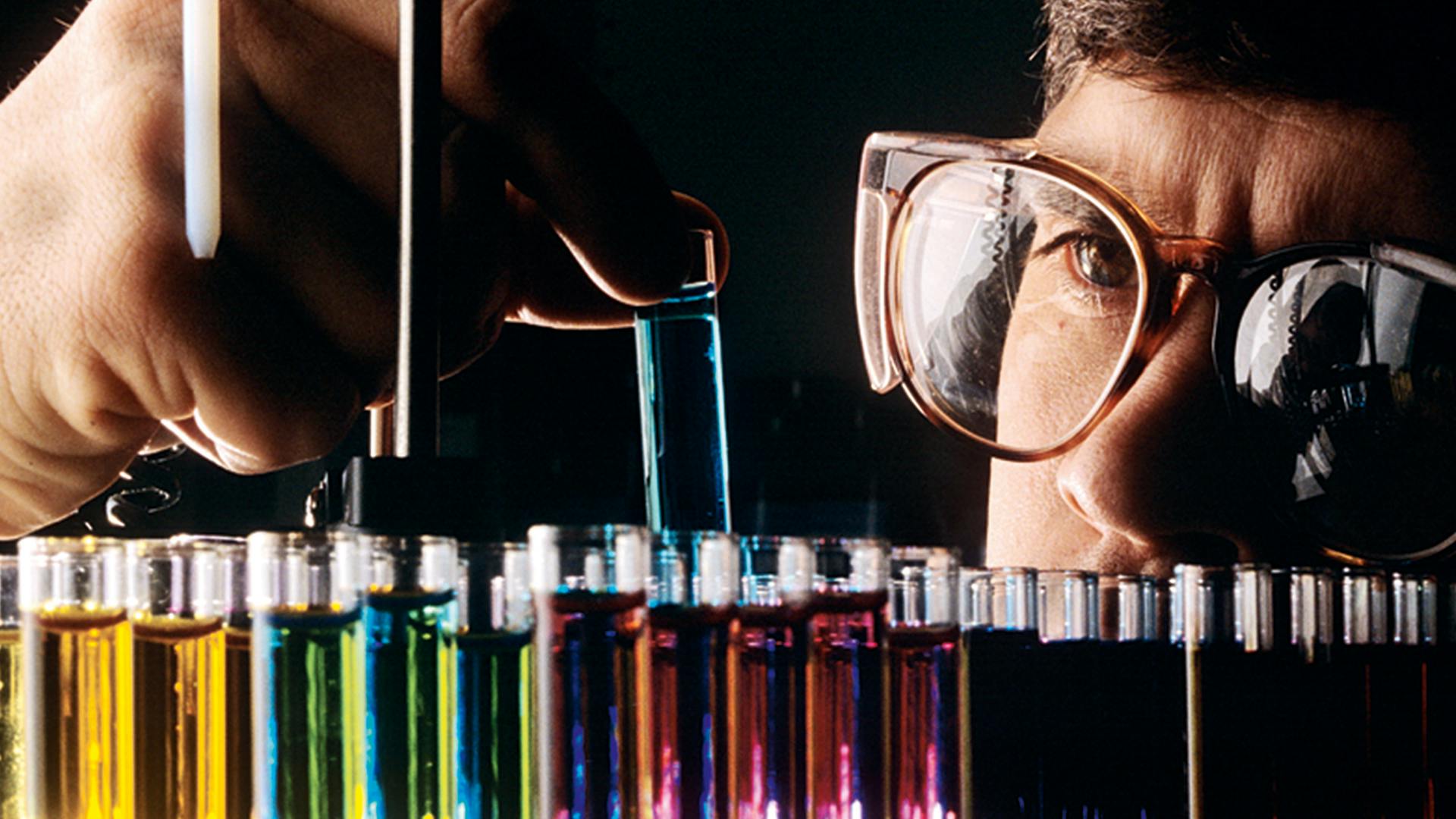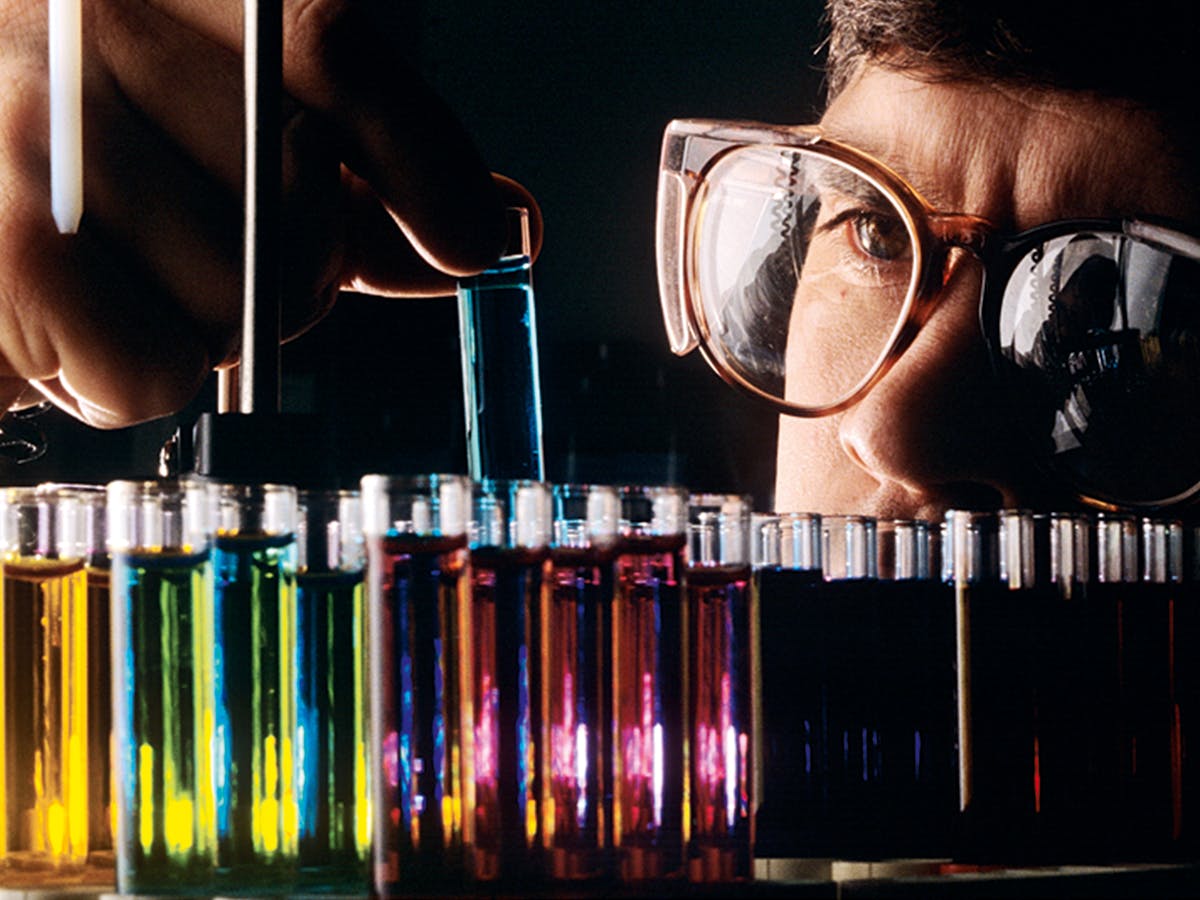
Ciba-Geigy Greensboro (North Carolina, USA). Research laboratory for dyestuffs, 1990.
The origins of the pharmaceutical industry – as with many other Swiss economic success stories – are to be found abroad. A key driver of the industry’s triumphant development was the French patent act of 1844. This act protected the product but not the manufacturing process, prompting many French chemists to move to nearby Basel, where the silk ribbon industry needed synthetic dyes. The fact that Switzerland did not introduce patent laws until 1888, and that the Swiss chemical industry – at its own request – remained exempt from this legislation until 1907, provided the sector with a strong momentum. The industry also benefited from Switzerland’s neutrality during the conflicts between France and Germany, which culminated in the wars of 1870/71 and 1914–18. As a result, Swiss chemical exports rose to seven times their 1913 level by 1920. This period also witnessed a development that can only be explained by the particular spirit of the time: In 1918, Ciba, Geigy and Sandoz joined forces to form a syndicate, known as Basler IG, to fend off competition from Germany. Behind the innocuous-sounding name was a strict cartel characterized not only by agreements on purchasing and prices, but also by a rigid profit-sharing formula and the clear division of business areas.
Early forays into pharmaceuticals
But the industry did more than just put up protectionist defenses. It also adapted to an adverse environment by setting up production sites abroad. By 1925, the Basel chemical industry already employed more than half of its workforce outside Switzerland. This early globalization went hand in hand with the expansion of the pharmaceuticals business. Ciba and Sandoz had begun to diversify into pharmaceuticals from the end of the 1880s onwards, Geigy came along later. The chemical industry’s advance into pharmaceuticals was to prove decisive. High-value creation, a strong knowledge-based environment, considerable internationalization and a better overall image than would have been possible from sticking to chemicals were all vital success elements for a small and open economy such as Switzerland’s.
Merger mania
In restructuring their industry through mergers and acquisitions, the Basel pharmaceutical companies were true pioneers, pulling off two of the most spectacular mergers in Swiss business history. The merger of Ciba and Geigy to form Ciba-Geigy on October 20, 1970 – the “Basel Marriage” as it was referred to in the German-speaking press – caused an uproar that took some time to die down. Public concern was not driven by the fear of job losses, since the two companies complemented each other well. Rather, critics bemoaned the amalgamation of two such traditional companies to form a new conglomerate. Another unnerving element was that, for tax reasons, the venerable 212-year-old J.R. Geigy was to be acquired by Ciba, a relative upstart with less than a century of history.
Even more decisive for the development of the pharmaceutical industry in Switzerland was the announcement on March 7, 1996 that Ciba and Sandoz were merging to form Novartis. Public concerns centered on potential job losses, though the stock market applauded the move – the news sent share prices soaring, with both stocks up by 25 percent within hours of the announcement. The deal’s strategic significance was crucial for the Swiss pharmaceutical industry as a whole, which had missed many opportunities for structural change.
Backing the right horse
One of the reasons why the merger was so unusual was that it did not create one company from two, but instead took two and turned them into several companies. While the pharmaceutical businesses were combined into the new company, chemicals production was spun off into two new companies: Clariant before the Novartis merger and Ciba SC after it. There was no way to do this without losing jobs. When Ciba SC was acquired in 2008 by Germany’s BASF, “after a long and difficult process” (Neue Zürcher Zeitung), the company had only 12 000 associates worldwide, down from 24 000 when the company was spun off from the “old” Ciba. Clariant went through a similar process. This confirmed the foresight of the architects of the 1996 merger – that in view of price pressure from China in particular, it would become almost impossible to continue mass-producing chemicals competitively in Western Europe in general, and in Switzerland in particular. In addition to industrial chemicals, in 2000 Novartis also spun off its agrochemicals business, merging it with that of the British-Swedish company AstraZeneca to form Syngenta – now the global market leader in crop protection and number three in seeds. The humble performance of the chemicals business was offset by the success of the visionary decision to concentrate on pharmaceuticals and, in doing so, to focus on research-intensive areas with high value added. A fundamental strategy review instituted in 2014 underscored the need to continue driving this process forward.
Growth and export driver
Despite the mergers and structural changes, the pharmaceutical industry in Switzerland was able to create jobs. What is more, both Novartis and Roche, the second Basel-based pharma giant, seem to be keeping faith with their homeland. The construction of the Novartis Campus and the Roche Tower are visible expressions of this commitment to Basel, while both companies have also helped create a pharma cluster on the shores of Lake Zug. Exports, meanwhile, grew even faster than jobs.
Switzerland as a center of research
One key aspect of the pharmaceutical industry is its need for a highly qualified workforce. Another is that it lends impetus to the research landscape. Thanks to its chemical and pharmaceutical industry, Switzerland features much more prominently on the world map of research than might be expected given the size of the country’s population. The universities and institutes in Zurich, Basel, Lausanne and Geneva are among the world leaders in life sciences, driving basic research and helping establish new start-ups.
Back on track
Biotechnology is at the heart of pharmaceutical research today. Although Switzerland kept up with the leaders in the early days of biotech, it failed to recognize the market and stock exchange potential of the industry. As a result, the first commercial successes in this field were achieved by California-based Amgen and Genentech. It took another feat of strength for the Swiss pharmaceutical industry to rejoin the top flight, when Roche took a majority stake in Genentech in 1990. Ciba and Sandoz subsequently bought into US biotech firms too. The successes of recent years nonetheless demonstrate that Switzerland was able to compete in terms of basic research and has now also caught up on the business front. Switzerland remains an important research center. The creation of Novartis was certainly key to getting back on track and maintaining the appeal of Switzerland as a research location. At the time of the merger, I made the following comment in the Neue Zürcher Zeitung newspaper: “The Ciba-Sandoz merger to create Novartis, as announced on Thursday, represents the most significant industrial policy event of recent economic history in Switzerland. By embarking on this venture, the managers of the two companies have found the courage to preserve the global competitiveness of ‘their’ companies by breaking long-held traditions, surrendering assets, and throwing ballast overboard. At the same time, they have proved that they have the forsight to do so from a position of strength.” The last years have done nothing to call this assessment into question – quite the contrary.
*Gerhard Schwarz, born in 1951, is one of Switzerland’s foremost economic commentators. He joined the Neue Zürcher Zeitung newspaper as an economics editor in 1981, becoming chief economics editor in 1994. He took on the additional role of deputy editor-in-chief 2008. He was director of the Avenir Suisse think tank in Zurich until 2016. His contribution was originally published in the print edition of live in March 2016.








